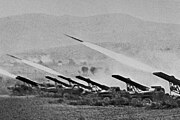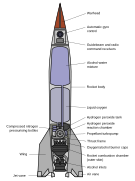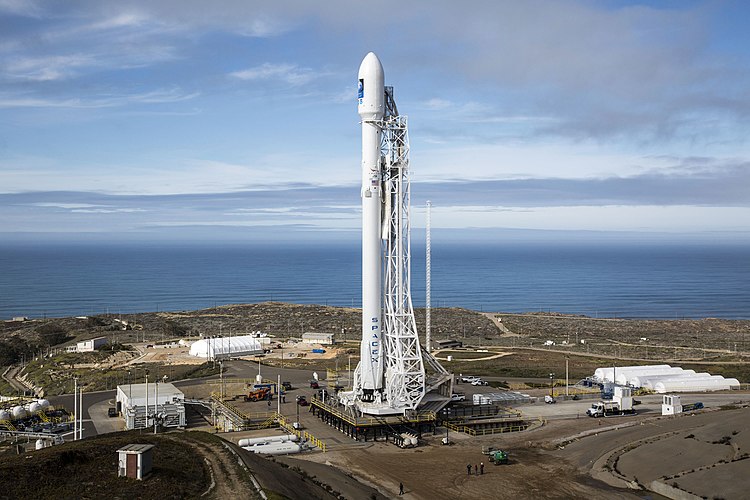Portal:Rocketry
The Rocketry Portal

A rocket (from Italian: rocchetto, lit. 'bobbin/spool') is a vehicle that uses jet propulsion to accelerate without using any surrounding air. A rocket engine produces thrust by reaction to exhaust expelled at high speed. Rocket engines work entirely from propellant carried within the vehicle; therefore a rocket can fly in the vacuum of space. Rockets work more efficiently in a vacuum and incur a loss of thrust due to the opposing pressure of the atmosphere.
Multistage rockets are capable of attaining escape velocity from Earth and therefore can achieve unlimited maximum altitude. Compared with airbreathing engines, rockets are lightweight and powerful and capable of generating large accelerations. To control their flight, rockets rely on momentum, airfoils, auxiliary reaction engines, gimballed thrust, momentum wheels, deflection of the exhaust stream, propellant flow, spin, or gravity.
Rockets for military and recreational uses date back to at least 13th-century China. Significant scientific, interplanetary and industrial use did not occur until the 20th century, when rocketry was the enabling technology for the Space Age, including setting foot on the Moon. Rockets are now used for fireworks, missiles and other weaponry, ejection seats, launch vehicles for artificial satellites, human spaceflight, and space exploration.
Chemical rockets are the most common type of high power rocket, typically creating a high speed exhaust by the combustion of fuel with an oxidizer. The stored propellant can be a simple pressurized gas or a single liquid fuel that disassociates in the presence of a catalyst (monopropellant), two liquids that spontaneously react on contact (hypergolic propellants), two liquids that must be ignited to react (like kerosene (RP1) and liquid oxygen, used in most liquid-propellant rockets), a solid combination of fuel with oxidizer (solid fuel), or solid fuel with liquid or gaseous oxidizer (hybrid propellant system). Chemical rockets store a large amount of energy in an easily released form, and can be very dangerous. However, careful design, testing, construction and use minimizes risks. (Full article...)
Selected article -

Between 1993 and 1996, the McDonnell Douglas DC-X, also known as the "Delta Clipper", conducted twelve low-altitude suborbital test launches to verify the configuration and handling of the uncrewed single-stage-to-orbit Delta Clipper design, which was proposed to the United States Department of Defense and the National Aeronautics and Space Administration (NASA) for use as a reuseable launch vehicle. Claimed as the first rocket to conduct a vertical landing on Earth, the DC-X was a one-third scale demonstrator for the proposed operational Delta Clipper vehicle.
After the first three flights Strategic Defense Initiative Organization funding for the test project was cancelled; the remaining test program was conducted by NASA and the Advanced Research Projects Agency. Following the eighth test flight, the vehicle was transferred fully to NASA and the vehicle was modified to DC-XA configuration, also known as "Clipper Graham" after General Daniel O. Graham who had died in 1995 after supporting the Delta Clipper project. (Full article...)In the news
- 17 August 2024 – Russian invasion of Ukraine
- Rockets launched by the Armed Forces of Ukraine destroy a Russian bridge over the Seym river in the Kursk Oblast, killing multiple volunteers who were evacuating Russian civilians. Russia's foreign ministry asserts that the missiles were launched by Western-made rocket launchers. (Reuters)
- 15 August 2024 – Israel–Hezbollah conflict
- Hezbollah launches four rockets at IDF targets in Shamir and Malkia in Upper Galilee which were intercepted by the Iron Dome causing a fire in Shamir and Ruwaysat al-Alam of Kfarchouba in southern Lebanon. (Al Jazeera)
- 13 August 2024 – 2024 Iran–Israel conflict, Israel–Hezbollah conflict
- Two Hezbollah militants, three Lebanese civilians killed, 21 injured in Israeli airstrikes on Hezbollah targets in Baraachit, Tyre, Aabbassiyeh, Kfarkela, At Tiri and Marjayoun in southern Lebanon. Hezbollah launches rockets at Kfarchouba, Shebaa Farms, Shtula, Kiryat Shmona and Beit Hillel. (Al Jazeera)
- 12 August 2024 – 2024 Iran–Israel conflict, Israel–Hezbollah conflict
- Hezbollah fires 30 Katyusha rockets targeting the IDF 146th Division headquarters in Ga'aton and an IDF surveillance station in Metula. An Israeli Iron Dome interceptor missile destroys an Avdon residence. (Al Jazeera)
- 10 August 2024 – Israel–Hamas war
- Israeli rockets strike Al-Tabaeen school in Gaza City during Fajr morning prayers, killing more than 93 Palestinians and injuring 47 others, several of whom were trapped in the building as it was damaged by a fire. (Al Jazeera) (Times of Israel)
- 8 August 2024 – Russian invasion of Ukraine
- Ukraine launches twelve rockets and 14 drones into Russia, according to both acting Governor of Kursk Oblast Alexei Smirnov and the Russian Ministry of Defence. (DW Russian)
Topics
List articles
Things to do
 |
Here are some tasks awaiting attention:
|
Wikimedia
The following Wikimedia Foundation sister projects provide more on this subject:
-
Commons
Free media repository -
Wikibooks
Free textbooks and manuals -
Wikidata
Free knowledge base -
Wikinews
Free-content news -
Wikiquote
Collection of quotations -
Wikisource
Free-content library -
Wikispecies
Directory of species -
Wikiversity
Free learning tools -
Wikivoyage
Free travel guide -
Wiktionary
Dictionary and thesaurus


















































